Inspiring Mentors Valrene Tweedie and Laurel Martyn

 Valrene Tweedie as an Odalisque in 'Scheherazade', Chicago, Ballet Russe de Monte Carlo, 1947-48 & Laurel Martyn in Vltava, Borovansky Ballet, 1940
Valrene Tweedie as an Odalisque in 'Scheherazade', Chicago, Ballet Russe de Monte Carlo, 1947-48 & Laurel Martyn in Vltava, Borovansky Ballet, 1940
Michelle Potter describes the contribution of two great figures of Australian dance.
(July 2002 ~ National Library of Australia)
http://pandora.nla.gov.au/pan/131760/20120120-0944/www.nla.gov.au/pub/nlanews/2002/jul02/story-2.pdf
At regular intervals the role of women in dance becomes a topic for discussion by dance commentators publishing in both the print and electronic media. Why are there so few women choreographers? Is there a place in today's society for the glamorous ballerina epitomised by former stars such as Margot Fonteyn? Is dance a male-dominated or female- dominated art form? Do men hold all the plum jobs? Dance in both its current practice and past history generates hotly contested debates on issues of gender, ethnicity, sexual politics and the like.
 Leone Vining Brown (b.1930) Margaret Barr Dance Drama group, 1972. Records of Ballet Australia, 1960-1976. Manuscript Collection MS9171. Courtesy of shane Vining Brown.
Leone Vining Brown (b.1930) Margaret Barr Dance Drama group, 1972. Records of Ballet Australia, 1960-1976. Manuscript Collection MS9171. Courtesy of shane Vining Brown.
While many of the best known figures in the development of Australian dance have been men- historically, Edouard Borovansky and Robert Helpmann come to mind immediately-over the years many women have also provided strong leadership roles. The work of a number of them is well documented in the National Library's Collection. The English-born Peggy van Praagh, founding artistic director of the Australian Ballet, and the Viennese modern dance pioneer Gertrud Bodenwieser, who brought her expressionist dance to Australia in 1939, are striking examples. The careers of both van Praagh and Bodenwieser are represented by substantial collections that cross the range of the Library's collecting areas. However, two Australian-born women, Valrene Tweedie and Laurel Martyn, also stand out for the contributions they have made across several decades.
Both Tweedie and Martyn had performing careers outside of their native country but both also returned to nurture Australian dancers and foster Australian choreography and performance. The careers of both are well documented in the Library and this material highlights the strength of their engagement with dance and, in particular, their determination to establish a creative environment for the production of new work.
 Valrene Tweedie in costume for Symphonie Fantistique, De Basil's Ballet Russe, Chicago 1940-41. 1 of 10 photographs:gelatin silver, 17x22cm or smaller, Pictorial Collection P1941/1
Valrene Tweedie in costume for Symphonie Fantistique, De Basil's Ballet Russe, Chicago 1940-41. 1 of 10 photographs:gelatin silver, 17x22cm or smaller, Pictorial Collection P1941/1
Sydney-born Tweedie left Australia in 1940, aged 15, with the Original Ballet Russe at the conclusion of that company's hugely successful Australia tour. For the next decade or so she danced across North and South America with an assortment of companies until she returned to direct the Melbourne-based National Theatre Ballet for seasons from 1953 to 1955. With the National she also choreographed and performed as one of the company's leading dancers.
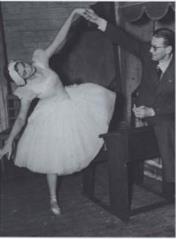 Valrene Tweedie (14 years old) with Colnel de Basil after being accepted for his ballet company, Sydney, 1940. 1 of 10 photographs:gelatin silver, 17x22cm or smaller, Pictorial Collection P1941/1
Valrene Tweedie (14 years old) with Colnel de Basil after being accepted for his ballet company, Sydney, 1940. 1 of 10 photographs:gelatin silver, 17x22cm or smaller, Pictorial Collection P1941/1
But it was in the 1960s and 1970s that Tweedie made a singular contribution to choreographic development in Australia. In 1960 she established Ballet Australia, an organisation designed to encourage new Australian choreography, music and design and to provide opportunities for this new work to be performed. Tweedie was a visionary in this regard and even today her broad outlook has rarely been equalled. Although the name Ballet Australia suggests a particular stylistic focus, Tweedie nurtured and encouraged choreographers working across a variety of dance styles from ballet to jazz, modern to primitive. She was a facilitator who provided artists with a creative environment in which to experiment and to grow.
 Laurel Martyn in "Vlatava", 1940. 1 of c865 photographs Geoffrey Ingram Archive of Australian Ballet. Pictorial Collection
Laurel Martyn in "Vlatava", 1940. 1 of c865 photographs Geoffrey Ingram Archive of Australian Ballet. Pictorial Collection
Ballet Australia gave its first performance in December 1960 at Sydney's Elizabethan Theatre. Four works were shown: Tweedie's Overture for Dancers, Ruth Galene's Cantilena, Judith Burgess' Bartok Sonata and Joan Halliday's Sea Interludes. Over the next several years, Ballet Australia presented a staggering array of new choreography, often with commissioned scores from some of Australia's leading composers_The period 1961 to 1962 was particularly productive musically. In three seasons, eight dance works were produced using music by contemporaty Australian composers. Six of the eight works were danced to brand new scores commissioned by Ballet Australia from John Antill, Nigel Butterley, Kurt Herweg, Bruce Lawrence, Richard Meale and John Milful.
 Leone Vining Brown (b.1930) John Meehan and Franz Verrenne with choreographer Dorothy Steane (reflected in the mirrir), Ballet Australia Choreographic seminar 1973. Records of Ballet Australia, 1960-1976. Manuscript Collection MS9171. Courtesy of shane Vining Brown.
Leone Vining Brown (b.1930) John Meehan and Franz Verrenne with choreographer Dorothy Steane (reflected in the mirrir), Ballet Australia Choreographic seminar 1973. Records of Ballet Australia, 1960-1976. Manuscript Collection MS9171. Courtesy of shane Vining Brown.
In 1964 choreographic workshops replaced the earlier Ballet Australia format of full-scale productions, and 1969 saw the first annual choreographic competition. This first competition was won by Nanette Hassall, who went on to establish her own performing career in the United States and the United Kingdom before returning to Australia in the 1980s to establish the Melbourne- based company Dance Works. Hassall is currently head of the dance department at the Western Australian Academy of Performing Arts, Edith Cowan University, Perth. Winners in subsequent years also went on to develop choreographic and directorial careers. They included Ian Spink, who in the 1980s co-founded Second Stride, a small contemporary dance company in the United Kingdom, and John Meehan, currently directing American Ballet Theatre's second company.
Tweedie's Ballet Australia appeared to have run its course by the mid- 1970s and was dissolved in 1977. By the 1970s the Australian dance scene had changed dramatically. The flagship company, the Australian Ballet, was into its second decade of operation and a number of strong, regional dance companies had blossomed. Tweedie's leadership in encouraging broadly based choreographic development remains, however, remarkable.
 Laurel Martyn in her dressing room 1946. 1 of c865 photographs Geoffrey Ingram Archive of Australian Ballet. Pictorial Collection
Laurel Martyn in her dressing room 1946. 1 of c865 photographs Geoffrey Ingram Archive of Australian Ballet. Pictorial Collection
Laurel Martyn's early dance training was in Queensland, but she left for England in the mid-1930s, while still in her teens, and continued her training in London before beginning a performing career with the Vic-Wells Ballet. It was in London that Martyn's own choreographic skills began to blossom. In 1935 her ballet Sigrid won second prize in the Pavlova Casket choreographic competition. On her return to Australia, Martyn danced with the Borovansky Ballet in its early years, before leaving it in 1946 to establish her own company, Ballet Guild.
Martyn was a prolific choreographer herself, and while she did encourage and produce the work of many other choreographers for Ballet Guild, and did reproduce some of the best-known classics of the ballet repertoire, Ballet Guild was also an important stage for her own work. In the 1940s and 195O's Martyn choreographed some of her best- known pieces on Australian themes, including The Sentimental Bloke in 1952 and Mathinna, the story of a young Aboriginal girl's entry into white society, in 1954. Between 1946 and 1976 when Ballet Guild (by then renamed Ballet Victoria) folded, Martyn had created over 25 original works herself. This was unlike Tweedie, who choreographed extensively for television in the 1960s and 1970s, but only rarely made works for Ballet Australia.
Nevertheless, the history of Ballet Guild reflects Martyn's overwhelming belief in the importance of establishing a creative environment in which new dance could flourish. As it was with Tweedie, one of Martyn's greatest contributions was her championing of Australian composers. The Sentimental Bloke was danced to a score by John Tallis; Mathinna to the music of Esther Rofe. Other Australian composers who worked with Martyn and Ballet Guild included John Antill, Dorian le Gallienne and Margaret Sutherland. The two women, Rofe and Sutherland, each made two works for Ballet Guild. In addition to Mathinna, Rofe created the music for L'Amour enchantee in 1950, and Sutherland composed music used in Dithyramb (1946) and The Selfish Giant (1947).
Unlike Ballet Australia, however, Ballet Guild continued throughout its life to present full-scale productions rather than the choreographic workshops and seminars that became a feature of Ballet Australia's later years. As a result, Martyn also commissioned stage and costume designs from leading Australian theatre designers including William Constable, Leonard French, Barry Kay, Alan McCulloch, Kenneth Rowell and John Truscott.
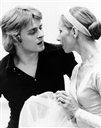
Mikhail Baryshnikov and Natalia Makarova 1974 Associated Press
In its final years, Martyn's company succeeded in bringing major guest stars to Australia, the most eminent being Mikhail Baryshnikov and Natalia Makarova, who guested in 1975 having only recently arrived in the West. The following year Galina and Valeri Panov, also recent defectors from the Soviet Union, danced with the company. But the future of the company was shaky. Financial and political issues had begun to impinge, and by 1976 the vision which Martyn had nurtured was in shreds. As Martyn commented in an oral history interview recorded for the Library in 1989:
"I'm not a politician. I haven't a politician's bone in my body. And that is a big drawback. If I'd had more of that in me perhaps Ballet Guild might have grown bigger and done what my vision for it was. But I think the creativity that we had was very worthwhile."
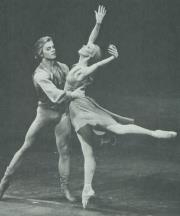
 Mikhail Baryshnikov and Natalia Makarova
Mikhail Baryshnikov and Natalia Makarova
Ballet Rehearsal (Natalia Makarova and Mikhail Baryshnikov)
1974/1976
Galina and Valery Panov
Senator Henry M. Jackson holding a copy of book, To Dance, with Russian dissidents and famed ballet dancers Galina and Valery Panov, April 26, 1978

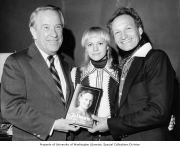
Martyn's contribution through Ballet Guild cannot, however, be underestimated. Like Tweedie, her vision was the creation of Australian dance, preferably in conjunction with Australian composers and designers.
Tweedie and Martyn have both continued to contribute to the development of dance in Australia, well into their 'retirement'. Martyn, now aged 86, has recently completed work on the second edition of her book about educating young dancers, Let Them Dance. Tweedie, in her 70s, appeared recently as guest artist with the Australian Ballet in cameo roles in two productions: Graeme Murphy's revitalised version of Nutcracker and Stephen Baynes' Requiem. These two remarkable women have enhanced Australian dance with their commitment and vision, and with their ability to act as inspiring mentors and facilitators.
********************************************************************************************
MICHELLE POTTER is Curator of Dance at the National Library. She previously authored the Library's publication A Passion for Dance and is currently compiling A Collector's Book of Australian Dance, due for release in October.
********************************************************************************************
The records of Ballet Australia are held as MS9171, and a collection of photographs and musical scores has recently been acquired from Laurel Martyn. Tweedie and Martyn were both interviewed as part of the Esso Performing Arts and Oral History Archive Project. Tweedie's interview is at TRC 2347, and Martyn's at TRC 2444.
Inspiring Mentors Valrene Tweedie and Laurel Martyn by Michelle Potter
July 2002 ~ National Library of Australia
http://www.nla.gov.au/pub/nlanews/2002/jul02/
Laurel Martyn OBE
 Laurel Martyn as Odette in 'Swan Lake' Act II, 1944. Photo:Ronald Esler
Laurel Martyn as Odette in 'Swan Lake' Act II, 1944. Photo:Ronald Esler
1997 Lifetime Achievement Award
Laurel had the vision and wisdom to create a system of teaching dance which steered away from the unimaginative teaching of a rigid syllabus, and focused on principles and purpose of movement, and creative expression. Passionate about dance teaching and the education of dance teachers, Laurel has had significant influence on the Australian dance world.
She was the first woman to be accepted into Vic-Wells Ballet (later Sadler’s Wells Ballet) in 1936, and soon she was a featured soloist. She danced with Borovansky for five years, before establishing the Ballet Victoria Guild, (later the Victorian Ballet Company and then Ballet Victoria). She established a school to work alongside the company and for which she created many original works, often collaborating with Australian composers and designers. In her later years, Laurel continued to feature as a guest artist with The Australian Ballet.
From Australian Dance Awards~
For outstanding achievements in Australian professional dance
http://www.australiandanceawards.net.au/award-winners/lifetime-achievement/laurel-martyn-obe
Martyn, Laurel (1916 - 2013)
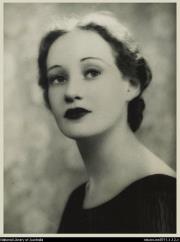 Portrait of Laurel Martyn, London, 1938. National Library of Australia
Portrait of Laurel Martyn, London, 1938. National Library of Australia
Born in Toowoomba, Queensland, as Laurel Gill, Laurel Martyn received her early dance training with Kathleen Hamilton in Toowoomba and Marjorie Hollinshed in Brisbane. In 1933 Martyn left Australia for further training. In England she studied with Phyllis Bedells and in 1934 won a choreographic scholarship from the Association of Operatic Dancing (later the Royal Academy of Dancing) with her first composition Exile. She passed all her Royal Academy exams to Solo Seal and in 1935 won the Adeline Genee gold medal, the second Australian to do so in the then short life of the competition, which began in 1931. In 1935 Martyn also arranged the dances for a production of The Waltz King and in the same year received second prize in a choreographic competition, the Pavlova Casket, for her ballet Sigrid.
Martyn joined the Vic-Wells Ballet (later Sadler's Wells Ballet) in 1936. She was the first Australian woman to be accepted into the company and by 1938 was a soloist. While in England she changed her name from Gill to Martyn, also a family name. She danced in many of Frederick Ashton's early ballets including Horoscope, Nocturne and Le Baiser de la fee and also spent time in Paris studying with the Russian emigre ballerinas Lubov Egorova and Mathilde Kchessinska.
Martyn came back to Australia in 1938 following the death of her father. On her return she took up a position in Melbourne with well-known teacher Jennie Brenan. While teaching for Brenan she was offered the dancing lead in Hiawatha, a pageant produced by T. E. Fairbairn and choreographed by Brenan, which opened in Melbourne's Exhibition Building on 21 October 1939. The ballet cast of 80 was led by Martyn, Serge Bousloff and Lawrence Rentoul. While performing in Hiawatha Martyn was noticed by Edouard Borovansky who persuaded her to join his fledgling Borovansky Ballet, which she did in 1940 following a brief return to Queensland. Martyn, along with Edna Busse and fellow-Queenslander Dorothy Stevenson, was Borovansky's leading artist in the early Borovansky days and she danced and created leading roles with Borovansky until 1945. Created roles for the Borovansky Ballet included the Spirit of the River in Borovansky's meditation on his Czech homeland, Vltava. While with Borovansky she also restaged Sigrid and reworked what is probably her best known work, En Saga, which premiered for the Borovansky Ballet in 1941.
Martyn left the Borovansky Ballet after her marriage to Lloyd Lawton in 1945. But in 1946, at the request of the Melbourne Ballet Club, Martyn took on the directorship of Ballet Guild, as the Melbourne Ballet Club had renamed itself. She was its director for an extended period. Ballet Guild became Victorian Ballet Company in 1963 and Ballet Victoria in 1967. Martyn was at the helm until 1973. She also established a school associated with Ballet Guild and students from the school augmented professional dancers in Ballet Guild productions. Martyn created many original works for Ballet Guild and Ballet Victoria productions and collaborated with Australian composers, including Dorian Le Gallienne, Margaret Sutherland, John Tallis, Esther Rofe, and Verdon Williams, and Australian designers, including Alan McCulloch, Len Annois, and John Sumner. Some of her works also had specifically Australian themes, notably The Sentimental Bloke (1952) and Mathinna (1954). Other significant works that Martyn made in this period included L'Amour enchantee (1950), a full-length Sylvia (1962), Voyageur (1956) and Eve of St Agnes (1966).
Martyn also developed a specific method for teaching dance especially to children, the principles of which she published in Let them Dance (1985). She also was instrumental in forming the Young Dancers' Theatre, for which she choreographed several works in the 1980s, and the Classical Dance Teachers Australia Inc, which provided in-service training for dance teachers. She was also on the steering committee for the Australian Institute of Classical Dance in the early years of its development. Martyn guested with the Australian Ballet as Mar in The Sentimental Bloke in 1985, as the mother of James in La Sylphide also in 1985, as Berthe, Giselle's mother, in Giselle in 1986 and as Miss Maud in The Competition (Le Concours) in 1989. In 1991 she reproduced Michel Fokine's Le Carnaval for the flagship company. In 1997 she was the recipient of the award for lifetime achievement at the inaugural Australian Dance Awards.
For more about the early years of Ballet Guild and Martyn's involvement in it see 'Inspiring mentors: Valrene Tweedie and Laurel Martyn', National Library of Australia News, July 2002.
Bibliography:
A list of Martyn's choreography from 1935-1991 is in Brolga 4 (June 1996), pp. 22-23. This issue of Brolga a special issue in honour of Martyn's eightieth birthday, contains a number of articles about Martyn's work.
From Australia Dancing http://www.australiadancing.org/subjects/42.html
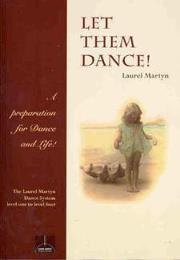 ABOUT LAUREL MARTYN OBE ~ Australian dancer, choreographer and teacher
ABOUT LAUREL MARTYN OBE ~ Australian dancer, choreographer and teacher
"I have danced all my life. The best reason for learning to dance is that you enjoy the sensation of moving and expressing your feelings and ideas through movement." Laurel Martyn OBE
At the age of four, Laurel began her dance training. She always considered herself to be a dancer, and has spent her whole long life involved in one or more aspect of this fascinating art form. She still continues her involvement at the age of 92 as advisor and mentor to the activities of our organisation.
Teaching and the development of expressive individuals who are able to realise their own unique abilities have always been important to Laurel. Her comprehensive experiences, combined with her enquiring approach to movement and life in general, have led to the development of a unique philosophy on movement and dance teaching, and the belief that this training contains valuable principles that apply to all styles of dance, to sports and to life itself.
Her approach, while still firmly based on the great traditions of the art of dance, has been developed to be in tune with the Australian way of thinking and living. This holistic approach has developed over decades of professional experience, and the Laurel Martyn Dance System continues to be an organic structure which allows for individual development and adaptation in response to emerging knowledge and demands. It is codified in her teaching manuals Let Them Dance & Help Them Dance.
For more info on Laurel Martyn visit her website at : http://www.laurelmartyndance.com/?page_id=30